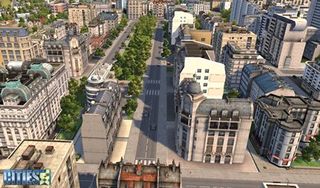While city-building games tend to simply drill themselves deeper into obsessive detail with each iteration, Monte Cristo is veering off in a more ambitious direction with Cities XL by fusing resource trading and web integration with the traditional taxing, zoning, and constructing you’re accustomed to. With up to 10,000 players occupying and developing each planet, and room for every mayor to interact over blogs, online profiles, and friends lists via the game’s web portal, Cities XL begins to look less like an urban development sim with an online component and more like an MMO for budding city planners.

Developer Monte Cristo is hoping that by having players work together and in competition with each other, they will use Cities XL to craft highly specialized cities, rather than each player climbing up an identical tree of unlockable structures and systems as they would in traditional city-builders. Maybe you’ll build a ski resort that invites upper class citizens and shuns the working class, for example, opting to trade luxury goods to your neighbors for the low-end goods you’re not producing in-house. In Cities XL, it’s all about outsourcing, and there’s no need to hire an e-lawyer, either: contracts for exchanging funds and materials will be “certified” by Monte Cristo.
Expect 500 buildings at release, with more introduced as paid and free downloadables over time, including maps meant to mimic real cities’ elevation, road systems, and other traits, along with licensed structures like the Chrysler Building, Empire State Building, and London City Hall. Fans of the Tycoon franchises will find familiar complexity ground in Gameplay Extension Modules (GEMs), which allow you to drop, say, a beach resort, amusement park, farm, or car factory into your town, and then tweak and customize it to suit your environment and the needs of its inhabitants. The ski resort GEM (planned to be the first available at launch) not only let us hand-draw slopes, for example, but our skiers became unhappy if the bunny hill we fenced off turned out to be a treacherous cliff (my bad - put the medical expenses on my tab, guys).

For documenting your city’s progress to the public, you can write in a web-based civic journal; posting screenshots of your skyscraper farm or the 10-mile suspension bridge you click-dragged through a canyon should earn the envy of the folks on your friends list. Monte Cristo also has planet-wide competitions planned: rally with your fellow mayors to be the least-polluting planet, or twirl your moustache like a villain and build a field of smokestacks to blot out their chance at success.
We still need to nurture a city ourselves from start to finish, and see how our urban planning plays out on a populated planet, but the marriage of multiplayer-driven gameplay with traditional city-building mechanics adds a welcome dimension to what’s traditionally been a “solo” genre.


+ Build the kind of city you want - no more being plugged into a linear urban tech tree. Curved roads, bridges, and tunnels that mold to the environment lay the groundwork for player freedom.
– Will multiplayer-tilted design, subscriptions, and microtransactions be a hassle, or allow players to pick and choose only the pieces of content they want to add their cities?
Oct 21, 2008
